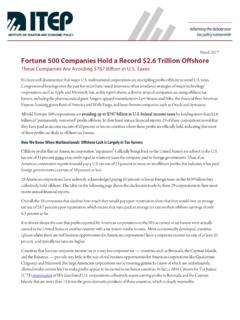Transcription of Information to be included with an application for ...
1 WHO MODEL LIST OF ESSENTIAL MEDICINES application Information to be included with an application for inclusion, change or deletion of a medicine in the WHO Model List of Essential Medicines: 1. Summary statement of the proposal for inclusion, change or deletion: .. 2 2. Name of the focal point in WHO submitting or supporting the application : .. 2 3. Name of the organization(s) consulted and/or supporting the application : .. 2 4. International Nonproprietary Name (INN, generic name) of the medicine: .. 2 5. Dosage form or strength proposed for inclusion.
2 2 6. International availability - sources, if possible manufacturers: .. 2 7. Whether listing is requested as an individual medicine or as an example of a therapeutic group: .. 3 8. Information supporting the public health relevance .. 3 Epidemiological Information on disease burden: .. 3 Assessment of current use: .. 3 Target population: .. 3 9. Treatment details .. 3 Reference to existing WHO and other clinical guidelines: .. 3 Dosage regimen, duration: .. 4 Need for special diagnostic or treatment facilities and skills: .. 4 10. Summary of comparative effectiveness in a variety of clinical settings.
3 4 Identification of clinical evidence (search strategy, systematic reviews identified, reasons for selection/exclusion of particular data) .. 4 Summary of available data (appraisal of quality, outcome measures, summary of results) .. 5 Summary of available estimates of comparative effectiveness .. 5 11. Summary of comparative evidence on safety:.. 6 Estimate of total patient exposure to date .. 6 Description of adverse effects/reactions .. 6 Special Populations .. 6 Drug Interactions .. 7 12. Summary of available data on comparative cost1 and cost-effectiveness within the pharmacological class or therapeutic group.
4 9 Range of costs of the proposed medicine .. 9 Comparative cost-effectiveness presented as range of cost per routine outcome .. 9 13. Summary of regulatory status of the medicine .. 9 14. Availability of pharmacopoeial standards (British Pharmacopoeia, International Pharmacopoeia, United States Pharmacopoeia) .. 9 15. Proposed (new/adapted) text for the WHO Model Formulary .. 9 WHO MODEL LIST OF ESSENTIAL MEDICINES application 1. Summary statement of the proposal for inclusion, change or deletion: This document proposes the inclusion of the tablet formulation of Tenofovir Disoproxil Fumarate/Lamivudine/Efavirenz (TDF+3TC+EFV) 300mg/300mg/600mg for treatment of HIV-1 infection among adults living with HIV/AIDS in both the WHO Essential Medicines List and the WHO Essential Medicines List for Adults.
5 The principal reasons for requesting this inclusion are as follows: Modern anti-retroviral therapy (ART) mandates the use of three or more drugs and this can require a large number of tablets to be swallowed each day and used lifelong. According to the WHO 2010 Treatment Guidelines TDF+3TC+EFV is one of the preferred first-line regimens for adults in resource-limited settings and is currently widely in use. As a fixed-dose combination with once-daily dosing, this formulation versus single drug formulations, may: Increase patient adherence to treatment; Delay the development of resistance; Lower the total cost, including production, storage, transport, dispensing and other health system costs; Reduce the risk of medication errors by prescribers, dispensers or patients themselves; and Simplify and increase security of supply systems 2.
6 Name of the focal point in WHO submitting or supporting the application : Marco Vitoria, WHO/HTM/HIV/ATC 3. Name of the organization(s) consulted and/or supporting the application : Clinton Health Access Initiative, Inc. 4. International Nonproprietary Name (INN, generic name) of the medicine: Tenofovir Disoproxil Fumarate/Lamivudine/Efavirenz (TDF+3TC+EFV) 5. Dosage form or strength proposed for inclusion: Each film-coated tablet contains 300mg tenofovir disoproxil fumarate (equivalent to 245mg of tenofovir disoproxil or 136mg of tenofovir), 300mg lamivudine, and 600mg efavirenz (WHO supported).
7 6. International availability - sources, if possible manufacturers: Tenofovir Disoproxil Fumarate/Lamivudine/Efavirenz tablets are manufactured at: Matrix Laboratories Limited F-4, F-12, Malegaon Sinnar, Nashik 422113 Maharashtra India WHO MODEL LIST OF ESSENTIAL MEDICINES application 7. Whether listing is requested as an individual medicine or as an example of a therapeutic group: Since EFV is a non-nucleoside reverse transcriptase inhibitor, and TDF and 3TC are nucleoside reverse transcriptase inhibitors, inclusion within FIXED-DOSE COMBINATIONS (under section ) is requested.
8 8. Information supporting the public health relevance Epidemiological Information on disease burden: UNAIDS reported in 2010 that 97% of the world s million people living with HIV/AIDS (PLHIV) were in low- and middle-income countries. In 2010 there were million new HIV-1 infections and million AIDS-related deaths. The 2011 WHO Progress Report for HIV/AIDS indicated that at the end of 2010 there were approximately million people in low and middle income countries on antiretroviral therapy (47% of those eligible for therapy) but only 456,000 children on ART, a near fold difference when compared to adults on treatment.
9 Lamivudine/Tenofovir/Efavirenz is indicated for the first-line treatment of HIV-1 infected adults and adolescents over 12 years of age. Assessment of current use: According to the WHO TUAPR, in 2010 nearly 530,000 adults (~11%) on first-line HIV-1 therapy were treated with TDF+3TC+EFV across 45 low- and middle-income countries (excludes the Region of the Americas). Target population: HIV-1 infected adults and adolescents over 12 years of age who have CD4 counts 350 cells/mm3 and for those with WHO clinical stage 3 or 4 if CD4 testing is not available.
10 Tenofovir/Lamivudine/Efavirenz is not approved for adolescents under 12 years of age or weighing less than 40kg. 9. Treatment details Reference to existing WHO and other clinical guidelines: The 2010 WHO adult antiretroviral therapy guidelines make the following recommendations for first-line regimens: When to start All adolescents and adults including pregnant women with HIV infection and CD4 counts of 350 cells/mm3, should start ART, regardless of the presence or absence of clinical symptoms. Those with severe or advanced clinical disease (WHO clinical stage 3 or 4) should start ART irrespective of their CD4 cell count.











